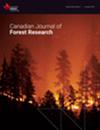幼树成活率与乔木密度、灌木覆盖和温度的关系在丰度比的基础上因大小类而异
IF 1.5
3区 农林科学
Q2 FORESTRY
引用次数: 0
摘要
全球变化驱动因素正在改变森林动态,但这些因素如何影响树木在大地理区域的早期发育阶段(即幼苗到幼树)的生存尚不清楚。我们开发了一种新的方法来评估幼苗和树苗的存活率。这种方法在美国东北部的一组系统森林清查地块上得到了证明,其中幼苗在六个高度类别中进行了统计,从而可以详细评估幼树发育中经常观察到的人口瓶颈阶段。包含研究物种的森林清查亚样地沿着环境或生态梯度划分为重叠的箱,并使用连续大小类之间的丰度比率来推断相对存活率。评价了10种常见树种与乔木密度、灌木盖度和年平均气温的关系。随着苗高等级的增加,与灌木盖度和大树密度的关系由正相关转为负相关。我们的研究结果表明,观察到的树苗和树木丰度的模式可能掩盖了对幼苗存活的复杂的、有时是相反的影响,这些影响在预测和管理成功的树木招募和未来的冠层树木组成时是重要的。本文章由计算机程序翻译,如有差异,请以英文原文为准。
Relationships between juvenile tree survival and tree density, shrub cover and temperature vary by size class based on ratios of abundance
Global change drivers are altering forest dynamics, yet how these factors influence tree survival across early developmental stages (i.e., seedling to recruited sapling) over large geographies is not well understood. We developed a novel approach to evaluate controls on seedling and sapling survival. This approach was demonstrated on a set of systematic forest inventory plots across the northeastern USA in which seedlings were tallied within six height classes, allowing for a detailed assessment of the stages at which demographic bottlenecks in juvenile tree development are often observed. Forest inventory subplots containing a study species were divided into overlapping bins along an environmental or ecological gradient, and ratios of abundance between successive size classes were used to infer relative survival rates. Relationships between ten common tree species and tree density, shrub cover and mean annual temperature were assessed. As seedling height class increased, we observed shifts from positive to negative associations with shrub cover and large tree density. Our results suggest that observed patterns of sapling and tree abundance may belie complex and sometimes opposing influences on seedling survival that are important to quantify when predicting and managing for successful tree recruitment and future canopy tree composition.
求助全文
通过发布文献求助,成功后即可免费获取论文全文。
去求助
来源期刊
CiteScore
4.20
自引率
9.10%
发文量
109
审稿时长
3 months
期刊介绍:
Published since 1971, the Canadian Journal of Forest Research is a monthly journal that features articles, reviews, notes and concept papers on a broad spectrum of forest sciences, including biometrics, conservation, disturbances, ecology, economics, entomology, genetics, hydrology, management, nutrient cycling, pathology, physiology, remote sensing, silviculture, social sciences, soils, stand dynamics, and wood science, all in relation to the understanding or management of ecosystem services. It also publishes special issues dedicated to a topic of current interest.

 求助内容:
求助内容: 应助结果提醒方式:
应助结果提醒方式:


